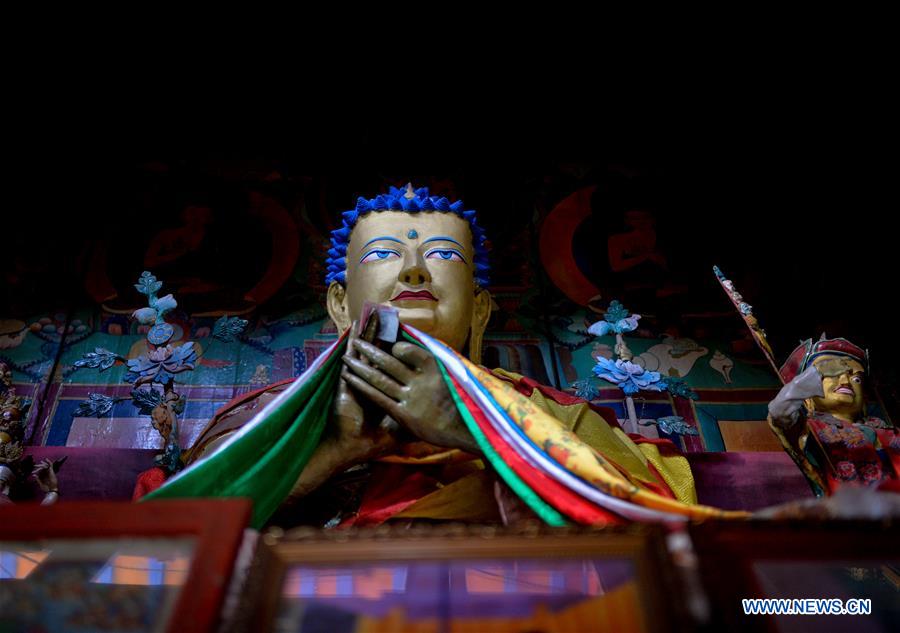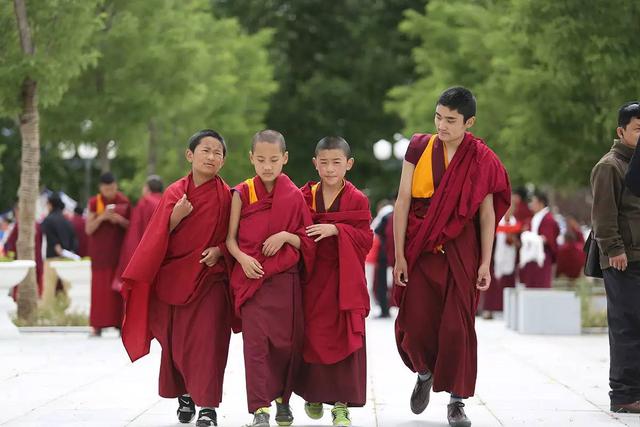10 Misunderstandings about Tibet (Ⅱ)
China's Tibet Autonomous Region's mystery and beauty has attracted visitors throughout the ages, but there has also been a great deal of misunderstandings surrounding Tibet. This article will clear some of those misunderstandings up.

Two Tibetan men hold hands and walk together. [Photo/travel.sina.com.cn]
Misunderstanding 6: If a man holds another man's hands, then they are homosexual (and likewise for women).
Reality: The enthusiastic Tibetans often take the initiative to shake hands with the others. Their left hand holds the other's two hands while their right hand claps the other's hands from time to time. If the Tibetans take tourists to visit the temples or sceneries, they will also hold each other's hands and shake hands back and forth. This has nothing to do with age and gender.
The behavior is sometimes mistaken by outsiders as a homosexual act or sexual harassment. In fact, the Tibetans are quite direct. If they think you are a "good man", then they will shake your hands firmly and passionately, and will be eager to show you their hometown. It is quite natural for two Tibetan friends to be holding hands while chatting with each other.

Giving someone the middle finger is generally a curse. [Photo/travel.sina.com.cn]
Misunderstanding 7: Giving someone the middle finger is also a curse in Tibet.
Reality: In Tibet, when evaluating something or somebody, Tibetans often use five fingers to show their opinion. The first rate, thumbs up, expresses compliments in the same way as most of other places around the world.
The second rate is an index finger. The expression is not that common unless used in some detailed evaluation.
The third rate is showing the middle finger, which is likely to infuriate foreigners or Hans. Actually, it is a fairly common behavior that signifies no particular opinion (and is definitely not a curse!).
The fourth rate is the ring finger. It is also less common, signifying a fair-to-middle viewpoint, or something barely satisfactory.
The last rate is the classic one, showing only the nail tip of the little finger. A contemptuous facial expression will probably also be shown, with cross-eyed stare at the tip of the little finger. It is terrible to accept such an assessment.

Palm up. [Photo/travel.sina.com.cn]
Misunderstanding 8: Palm up means begging.
Reality: The "palm up" gesture has a high-level background from a broad range of culture. When the guest is served with tea by the host, he/she could place their palms upwards to express thanks and decline more politely.
In religious activity, when the Rinpoche or Kampo places their palm up, the event ends and lamas are allowed to stand up and leave. In the Buddhist college, if the Kampo wants the next lama to recite Buddhist texts, debate Buddhist scripture, or just stop doing something, he could place his palm up without saying anything. The lamas will understand the gesture immediately.
Placing your palm up is one of the most elegant gestures in Tibetan culture; however, there are also different meanings for when one uses just one hand or two hands. The two-hands palm up, which is similar to the behavior of presenting an hada, implies "good luck", "take care", "have a seat", "have some tea", "see you later", etc.

The album of "Voices from the sky" [Photo/travel.sina.com.cn]
Misunderstanding 9: "The day, the month, the year and the age……" is a line from Tsangyang Gyatso's poem.
Reality: Actually, the lyric first appeared in a song named "Believer" from a famous album called "Voices from the sky", not Tsangyang Gyatso's poem. Tsangyang Gyatso is the 6th Dalai Lama and a famed poet in Tibet's history. His short and enigmatic life is full of romance and freedom, leaving later generations a mass of exquisite poems.

Photo shows the scenery of Lhasa, Tibet. [Photo/travel.sina.com.cn]
Misunderstanding 10: Tibetans are poor.
Reality: Although the remote areas of Tibet still needs further development, big cities and prefectures like Lhasa and Nyingchi have maintained a high-level of living standards because of plentiful national preferential policies, public subsidies, rich tourism, resources, etc.
In 2015, Tibet has maintained a 12-percent growth target with strong investment from the central government, while several Chinese provinces have lowered their growth targets amid an economic downturn.
According to an annual government work report delivered by Losang Jamcan, chairman of the regional government, Tibet's gross domestic product (GDP) is expected to hit 92.5 billion yuan (15 billion U.S. dollars) in 2014, maintaining its double-digit growth since 1994.
Your Comment
Name E-mailRelated News
-
;
-
-

-
Ancient Cagar Monastery in China's Tibet
Photo taken on Jan. 4, 2016 shows a Buddha in Cagar Monastery on the mountain in Gyirong Township of Gyirong County, Shigatse City.
-
-
-

-
Uncovering the monastic life of young Tibetan rinpoches
11-year-old Tibetan boy Lozang Dorje was recognized as the seventh Dechöe Rinpoche when he was six-years-old.
-
-
-

-
Sunshine casts on snow mountains, SW China's Tibet
Sunshine casts on a snow mountains in Gyirong Township of Gyirong County, southwest China's Tibet Autonomous Region.
-
-
-

-
Gansu steps up protection of Tea Horse Road
Nearly one thousand cultural relics about the North Tea Horse Road were displayed recently at the Tea Horse Road Cultural Museum.
-
Based in Lhasa, Tibet Vista is a Tibet travel agency that specialized in Tibet permit, and Tibet tours for both private and group travelers at a local price!
•4 Days Lhasa City Group Tour from USD 460 •8 Days Everest Base Camp Group Tour from USD 850 •15 Days Mt.Kailash Group Tour from USD 1780 •2016 Tibet Train Tours from Beijing, Shanghai, Chengdu, Xining,etc










